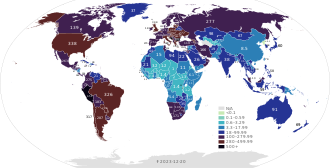
Back مناطق انتشار جائحة فيروس كورونا حسب الدولة والمنطقة Arabic Ölkə və ərazilər üzrə COVID-19 pandemiyası Azerbaijani Pandemi COVID-19 maumpat nagara BJN দেশ ও অঞ্চল অনুযায়ী কোভিড-১৯ এর বৈশ্বিক মহামারী Bengali/Bangla Pandemie covidu-19 podle zemí Czech Pandemia de COVID-19 por país y territorio Spanish Koroona levik maailmas Estonian دنیاگیری کووید-۱۹ بر پایه کشور و سرزمین Persian Pandémie de Covid-19 par pays et territoire French Pandemia de COVID-19 por territorios Galician
| COVID-19 pandemic | |
|---|---|
 | |
| Disease | COVID-19 |
| Virus strain | SARS-CoV-2 |
| Source | Probably bats, possibly via pangolins[2][3][4] |
| Location | Worldwide |
| First outbreak | China[5] |
| Index case | Wuhan, Hubei, China 30°37′11″N 114°15′28″E / 30.61972°N 114.25778°E |
| Date | First case of COVID-19: 17 November 2019
Public health emergency of international concern: 30 January 2020 – 5 May 2023 (3 years, 3 months and 5 days) |
| Confirmed cases | 777,114,582[6] |
Deaths | 7,079,582[6] |
| Vaccinations | |
This is a general overview and status of places affected by severe acute respiratory syndrome coronavirus 2 (SARS-CoV-2), the virus which causes coronavirus disease 2019 (COVID-19) and is responsible for the COVID-19 pandemic. The first human cases of COVID-19 were identified in Wuhan, the capital of the province of Hubei in China in December 2019. It spread to other areas of Asia, and then worldwide in early 2020.
The figures presented are based on reported cases and deaths. While in several high-income countries the ratio of total estimated cases and deaths to reported cases and deaths is low and close to 1, for some countries it may be more than 10[7] or even more than 100.[8] Implementation of COVID-19 surveillance methods varies widely.[9]
- ^ The data is from the deaths per million column of Template:COVID-19 pandemic death rates by country. See that template's reference for more info.
- ^ "Coronavirus very likely of animal origin, no sign of lab manipulation: WHO". Reuters. 2 April 2020. Archived from the original on 30 July 2020. Retrieved 23 April 2020.
- ^ Lau SK, Luk HK, Wong AC, Li KS, Zhu L, He Z, et al. (April 2020). "Possible Bat Origin of Severe Acute Respiratory Syndrome Coronavirus 2". Emerging Infectious Diseases. 26 (7). U.S. Centers for Disease Control and Prevention (CDC): 1542–1547. doi:10.3201/eid2607.200092. ISSN 1080-6059. OCLC 1058036512. PMC 7323513. PMID 32315281. S2CID 216073459.
- ^ Zoumpourlis V, Goulielmaki M, Rizos E, Baliou S, Spandidos DA (October 2020). "[Comment] The COVID‑19 pandemic as a scientific and social challenge in the 21st century". Molecular Medicine Reports. 22 (4): 3035–3048. doi:10.3892/mmr.2020.11393. PMC 7453598. PMID 32945405.
- ^ Ma J (13 March 2020). "Coronavirus: China's first confirmed Covid-19 case traced back to November 17". South China Morning Post. Retrieved 20 October 2021.
- ^ a b c d e Mathieu, Edouard; Ritchie, Hannah; Rodés-Guirao, Lucas; Appel, Cameron; Giattino, Charlie; Hasell, Joe; Macdonald, Bobbie; Dattani, Saloni; Beltekian, Diana; Ortiz-Ospina, Esteban; Roser, Max (2020–2024). "Coronavirus Pandemic (COVID-19)". Our World in Data. Retrieved 9 January 2025.
- ^ "Estimation of total mortality due to COVID-19". Institute for Health Metrics and Evaluation. 22 April 2021. Retrieved 26 June 2021.
- ^ Wiens KE, Mawien PN, Rumunu J, Slater D, Jones FK, Moheed S, et al. (March 2021). "Seroprevalence of anti-SARS-CoV-2 IgG antibodies in Juba, South Sudan: a population-based study". medRxiv 10.1101/2021.03.08.21253009v1.
- ^ Ibrahim, NK (November 2020). "Epidemiologic surveillance for controlling Covid-19 pandemic: types, challenges and implications". Journal of Infection and Public Health. 13 (11): 1630–1638. doi:10.1016/j.jiph.2020.07.019. PMC 7441991. PMID 32855090.
Cite error: There are <ref group=note> tags on this page, but the references will not show without a {{reflist|group=note}} template (see the help page).